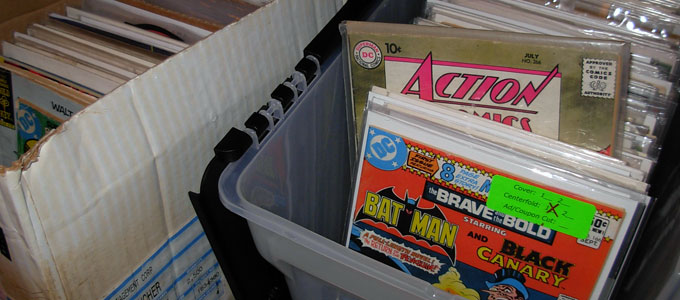This page may contain one or more affiliate links, which means that if you purchase a product through that link, I may receive compensation. The links will be identified with the text "affiliate link". Click to learn more.
Warning: collecting comics is extremely fun and addictive.
Perhaps you would like to collect old and rare comics for profit. Or perhaps you simply want to complete your collection of Batman or Spider-Man comic books. Either way, I figure that I could help guide you with some tips and tricks. Do not worry if you are a beginner. It is simple!
First decide why you want to collect comics in the first place. If you are doing it to get rich, forget it. It is impossible to predict what series’ will gain enough momentum to the point where people will have heavy demand for back issues, thus raising its initial value. In addition, there are many popular comics that are worthless monetarily because a billion copies were printed to begin with. The idea of buying comics for the sole reason of hoping they will raise in value later was a major cause of the industry crash during the 90s.
If you want to know how to collect comics so that you can read an entire series, for example, there may be a more economical way than trying to track down every issue. Marvel Unlimited lets you view seemingly every Marvel comic in existence, with the exception of anything published within the last six months. (The comics, in this case, are digital. If collecting digital comics is your bag, the decision is simple: Comixology will make you happy.)
Where to Find Comics
The first crucial step in knowing how to collect comics is knowing where to find them. For off-the-rack current issues, a good place to start is TFAW. Especially useful is their nick-and-dent section, where they sell slightly scuffed books at heavy discounts. They also offer 50-cent grab bag comics, which is a tempting treat to round off your order.
For back issues from the past few decades, your best bet is Lone Star Comics (Affiliate Link). They carry nearly every comic you have ever heard of. Its strength is its ease in locating hard-to-find issues. If a comic you want is not available, adding it to your Want List will cause them to e-mail you when they have it in stock. With the exception of super-rare comics, which are often ridiculously over-inflated, prices on this site are very reasonable. Another site good for locating back issues is Mile High Comics, however their site is less user-friendly.
If you are looking for how to collect comics from the silver or golden age (translation: old and rare comics that are often valuable) then you may already know where to look: eBay. The popular auction site is great for determining what things are really worth. If the price is too high, people will not buy it; it is as simple as that. You may not get an extraordinary deal, but you will have an excellent chance in acquiring exactly what you were intending.
How To Store Comics
Now that you have a collection of comic books, you may wonder how to collect comics where they will be neat and safe. You should try and store them at room temperature where the climate will not be too warm, which could cause the paper to turn brittle. Storing them in the cellar is the worst thing you could do. The moisture will get to the paper and will make your comics warp, smell and turn moldy. If you are storing your collection for a long period of time, consider getting a Rubbermaid-type container with a snap lid that will be air tight. Choose a plastic that is not transparent to prevent the light from damaging your prized collection.
The problem with plastic containers however is that it is not an economical solution if you have a massive collection (which most people do) nor is it convenient to browse for particular issues you would like to read again. What most people do is they get cardboard containers that are specifically designed to hold comic books. Beside being cheaper, cardboard is light and easy to stack. A reliable brand is BCW, which provides both “long boxes” and “short boxes”, which are exactly what they sound like. Short boxes hold a range 150 – 175 comics, where long boxes hold around 200 – 225 books. The box shape allows the books to stand upright and lets you browse them easily, as if going through a file in your office.
You may have heard the phrase “bagged and boarded”. This is referring to when individual comics are protected in a plastic bag with a piece of cardboard to keep it from bending. Older comics (“Silver Age”) are sized differently than modern comics, which means you have to be careful not to buy the wrong sized bags and boards. As mentioned before, BCW is a good brand, but honestly the brand does not matter much (TFAW sells BCW bags and boards). There are stronger plastic bags available made from Mylar, a plastic that is “resistant to the diffusion of oxygen”, whatever that means. Somehow this leads to less yellowing of the pages, less moisture and longer-lasting bags. Honestly though, you will never tell the difference and is completely unnecessary unless you are housing ancient and priceless comics.
What Are You Waiting For?
Now that you know the basics of how to collect comics, go out there and get reading! Do you have any tips for collecting? Leave a comment below.


